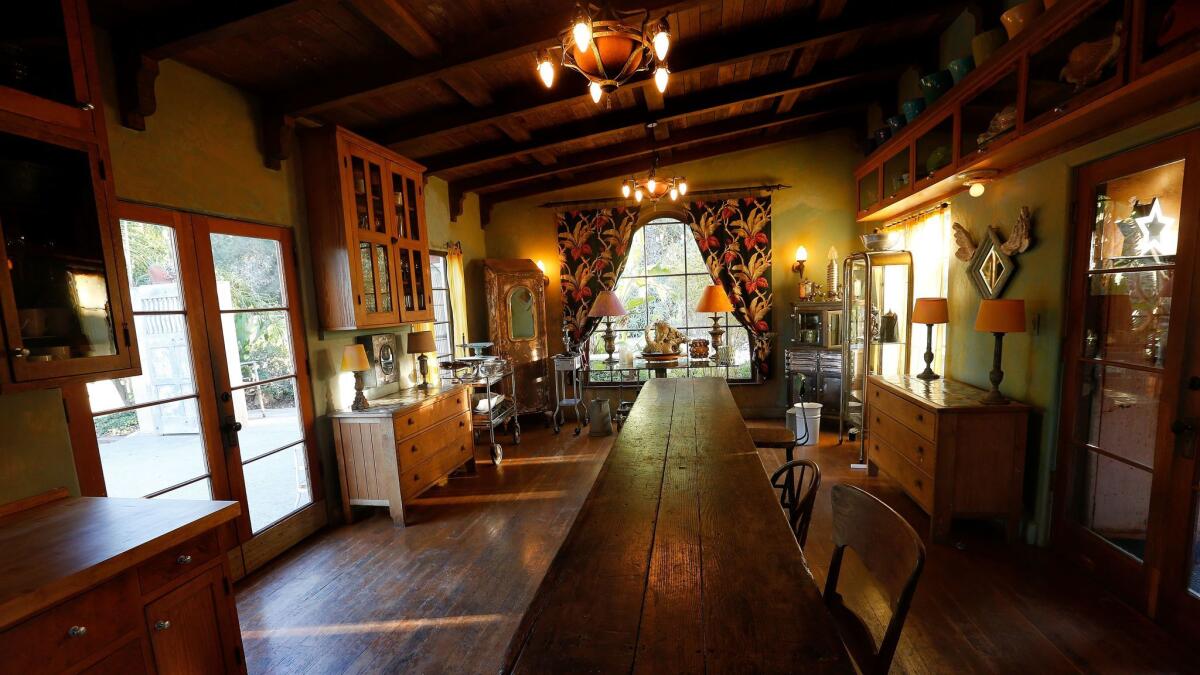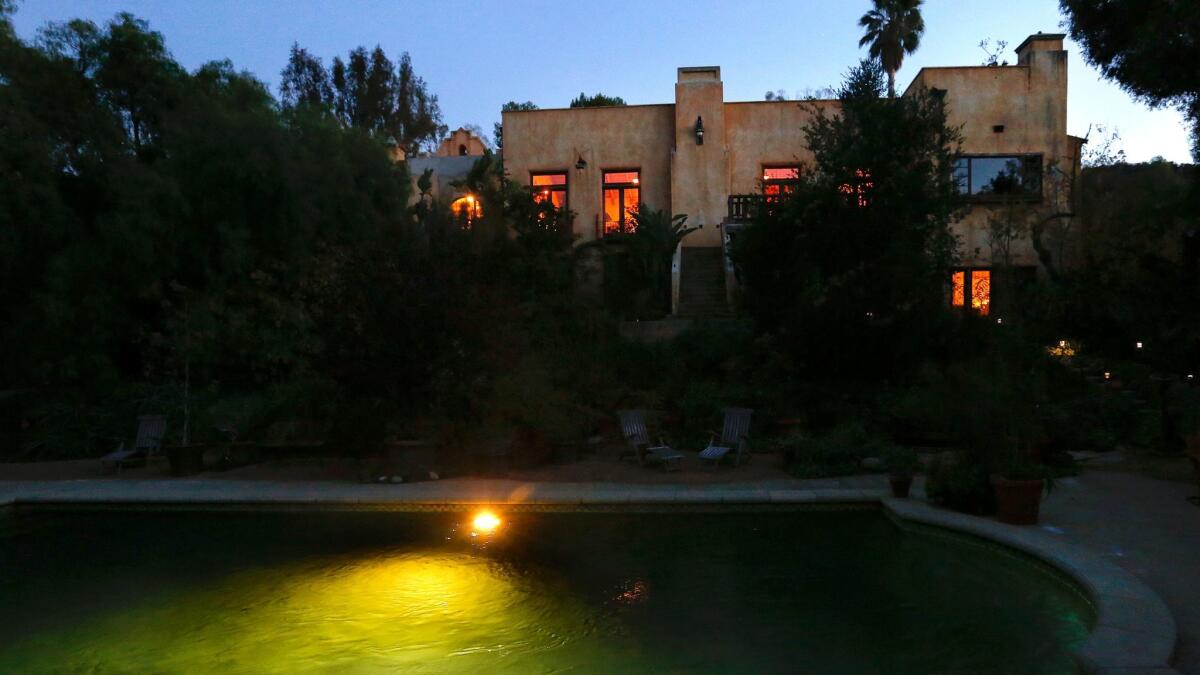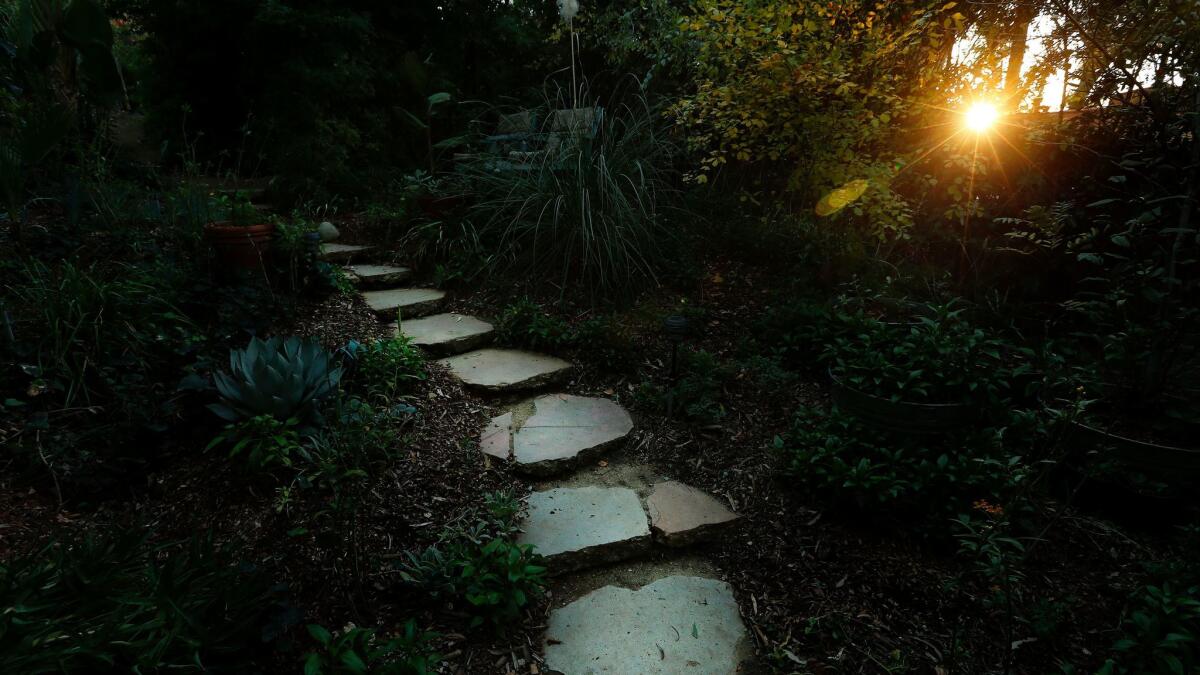Major reboot of Topanga house and gardens was a passion project, builder-owner says: ‘I was hopelessly in love...’

- Share via
When experienced home builder and sometime illustrator Bill Buerge calls the restoration of the Mountain Mermaid his “ultimate challenge,” he isn’t kidding.
“Piles of exterminated bees, horse manure and goat poop littered the floors. Most of the plaster had fallen from the walls,” he recalls. That’s just on the inside of the 7,000-square-foot Spanish Colonial Revival-slash-Mission Revival structure nestled in Topanga Canyon.
Out in the five-acre garden, invasive plants ruled. Large eucalyptus trees were especially troublesome. Roots snaked beneath the property and up through the shower floor 50 feet away. Meanwhile, water runoff chipped away at the foundation, causing the whole structure to list.

It was enough to scare away a few buyers, but not Buerge. “I was hopelessly in love with this floundering water-logged Mermaid,” he says.
He compares the Mermaid’s appeal to a siren song. Irresistible.
Perhaps it was the Mermaid’s checkered past; previous incarnations include a country club, a dude ranch, a gay bar, a Jewish boys’ school, and even an upscale brothel and gambling joint run by gangster Mickey Cohen. Built in 1930, it was called the Mermaid Tavern at one point, and Buerge retained that name.
Perhaps it was the bucolic location that drew Buerge as well, as he doggedly pursued his siren and eventually moved into the property on New Year’s Day 1990.
Buerge immediately went about putting the Mermaid back together. With the help of semi-retired contractors and workmen, he built a new foundation and brought the structure up to code. His seemingly endless to-do list included: upgrading the Mermaid’s electrical, plumbing and heating systems; straightening and insulating the walls; rebuilding the fireplace; refinishing the antique floors; and replacing a leaking roof with mission tile.

It took Buerge about three years to address the major issues and gain a certificate of occupancy from the Department of Building and Safety. He has been fine-tuning the property ever since. In the meantime, he also turned his attention to the Mermaid’s gardens.
At first, Buerge read books, joined gardening clubs and worked with landscape designers to rework the Mermaid’s gardens. Eventually, he gained enough confidence to undertake the garden design himself.
Today, the Mermaid is once again a place of beauty — not to mention the site of many photo shoots and events. The once desolate garden is now a serene retreat of meandering paths, cool shade and 15 flowing fountains. “Birds and bees abound. Snakes slither. Lizards patrol. Bunnies hop. Raccoons, possum, coyotes and bats come to life at night,” says Buerge, “It’s a magnet for wildlife.”
It has the paperwork to prove it too. The Mermaid’s lush garden is one of the National Wildlife Federation’s Certified Wildlife Habitats. It’s a designation that Buerge says came naturally. The garden already met the prerequisites for certification. It provides food, water, shelter and places for reproduction.

Buerge employs two men, Sergio Jimenez and Stevie Montes de Oca, to maintain the garden and the structure. The two prune, rake and repair throughout the property. Rather than use chemical pesticides, the gardeners pull weeds by hand and spray the leaves with soapy water, which can kill spiders and ants that harm the foliage.
Butterflies are the garden’s special guests. Monarchs, western tiger swallowtails, mourning cloaks and California sisters are just a few of the garden’s VIPs.
For them, Buerge and his two gardeners plant several kinds of milkweed, lantana and sedum, which are magnets for these winged creatures. California natives, succulents and grasses add to the garden’s verdant surroundings.
Butterflies even have special accommodations at the Mermaid. Once spotted in the gardens, a caterpillar egg is carefully transferred into a 100-square-foot mesh enclosure built by Jimenez, where it is protected from predators. Jimenez says there are plans to build an even larger 1,000-square-foot enclosure in the near future.
With the help of his daughter, Luna, Jimenez makes sure each butterfly has enough to eat and drink. When a giant swallowtail butterfly hatches, for example, the two set aside organic citrus fruits for them to feed on.
Buerge says special consideration is given to these winged creatures because of their dire straits. “They’re the most beautiful creatures in nature, but they are getting wiped out around the world.” For example, the monarch butterfly population has declined 90% in the last two decades.
Beth Pratt-Bergstrom, California director for the National Wildlife Federation and author of “When Mountain Lions Are Neighbors,” says places like Buerge’s gardens are important links for wildlife trying to make their way in the world.
“A garden and an edifice like this can quickly begin to look rough around the edges, malfunctions and deteriorates without constant attention,” she said. “But we are terribly passionate about the place and its resident wildlife, don’t mind the effort, and love what we do.”

TIPS ON BUILDING A HABITAT OF YOUR OWN
Setting up your own wildlife habitat isn’t as complicated as you might think. Here’s a list of what you need, whether you have a balcony or a sprawling garden:
- Food. For cramped spaces, set out a bird feeder. Larger gardens should have plants that produce nectar and pollen in the spring and summer and berry in the fall and winter.
- Water. Set out a shallow dish of water or consider a pond.
- Shelter. Plants can provide natural cover for creatures in need of shelter — even dead trees can work. If you have limited space, think about cozy bird houses.
- Place to care for their young. The three basic survival needs are covered above, but for the cycle to be self-perpetuating, wildlife need places where they can care for their offspring. Many places for shelter can also double as locations for wildlife to raise their young, such as birdhouses. You can also provide host plants for butterflies to munch on while in their caterpillar stage. Monarchs eat only milkweed at this stage, for example.
- Go green in the garden. Just as we need clean environments to survive, so do wildlife. Veer away from chemical pesticides and think about harvesting rainwater to help keep your garden green.
Need more ideas? Check out the wildlife federation website.
UPDATES:
11 a.m.: This article was updated to include more history about the house.
This article was originally published at 7 a.m.






